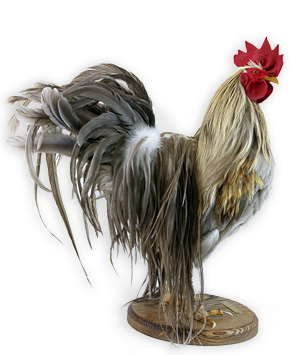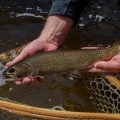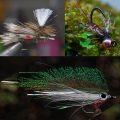Fly Tying: What Is “Genetic Hackle”
Have a question you want answered? Email it to us at ask@midcurrent.com.
Question: What is “genetic hackle”? Isn’t all hackle genetic?
Bob B., Bay St. Louis, LA
 Answer: When someone talks about “genetic hackle,” what they are really talking about are feathers from birds that have been genetically engineered through selective breeding to produce feathers especially for fly tying. Take a gander at one of the Whiting Farms birds, for instance—some of which are the end result of 80 years of selective breeding—and you’ll note that they don’t much look like barnyard chickens. These are exotic, fragile animals. Their cape and saddle feathers are now so long that breeders had to create longer-legged birds just to keep the valuable feathers from dragging on the ground.
Answer: When someone talks about “genetic hackle,” what they are really talking about are feathers from birds that have been genetically engineered through selective breeding to produce feathers especially for fly tying. Take a gander at one of the Whiting Farms birds, for instance—some of which are the end result of 80 years of selective breeding—and you’ll note that they don’t much look like barnyard chickens. These are exotic, fragile animals. Their cape and saddle feathers are now so long that breeders had to create longer-legged birds just to keep the valuable feathers from dragging on the ground.
And it’s not just length that hackle farmers are after. They’re also trying to produce feathers with greater barb density, which means fewer turns of the feather are necessary on each fly. In their natural state, feathers have longer barbs on one side, so barb symmetry requires careful breeding. Then there’s the rachis, which fly tiers incorrectly refer to as the quill. Tiers need the rachis to be pliable without being brittle, with a shape that resists twisting. The list of desirable traits goes on.
According to Dr. Tom Whiting, the Doctor Moreau of chickens, it’s a never-ending challenge to produce birds with high-quality feathers that are perfectly proportioned for fly tying. Once you’ve bred the kind of bird you want, you don’t just sit back and reap the rewards.
“It takes a lot of selection pressure just to keep the birds where they’re at, which is an unnatural state,” he says. Breeders have created the feathers that tiers want “by identifying, isolating, stabilizing, and perpetuating novel mutations,” he explains.
Strangely, the color of the feathers is not something he spends much time worrying about.
“No matter what color comes out of the breeding process, we can find a use for it,” he says.
The exceptions to this rule are the rare and highly valued colors such as cree.
“Cree can be maddening,” says Whiting,” because it doesn’t ‘breed true.’ It’s actually a three-way cross of colors, making it nearly impossible to predict.”
Ultimate, Whiting argues, the chicken itself is little more than a life-support system for the follicles that produce tying feathers, in the same way that sheep exist to produce wool.











